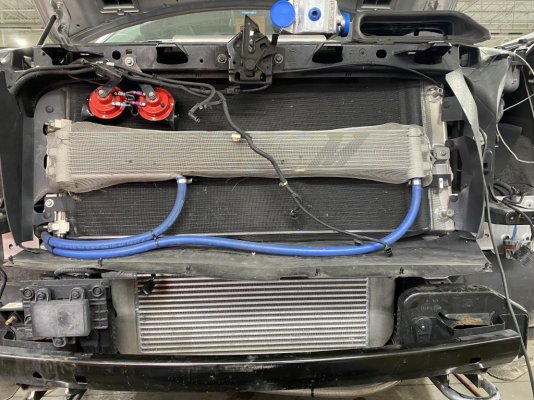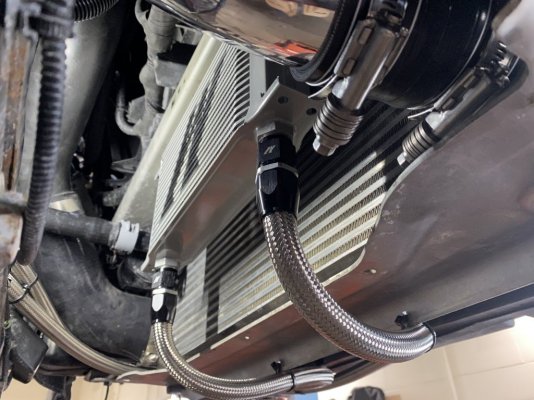You are using an out of date browser. It may not display this or other websites correctly.
You should upgrade or use an alternative browser.
You should upgrade or use an alternative browser.
Transmission Cooler for 2018 Expedition/Navigator 4x4
- Thread starter jmslade
- Start date
Disclaimer: Links on this page pointing to Amazon, eBay and other sites may include affiliate code. If you click them and make a purchase, we may earn a small commission.
Silver-Bullet-Bus
Well-Known Member
Silver-Bullet-Bus
Well-Known Member
Shakeandbake
Active Member
I didn't want to start a new thread.. but do all 22+ now have oil coolers? I searched under my Timberline, expecting to see the Raptor style oil cooler... but don't see it in the front. Searching my VIN there seems to be a Trans Oil Cooler: Part# ML3Z7869C
theblackpearl
Active Member
So I've read that the optimum operating range of the 10R80 transmission on these cars is between 200-220... and they don't perform well when it is 170-180F: have heard that they get jerky below this range. How are you accounting for that?Hilly,
10R80, PBH cooler adapter bracket at the bottom.
My Ford mechanic builds race cars, does all the 3.5 VCT’s, & mustang supercharger installs & enjoys doing custom work.
We towed today & ECT’s were 190-210 200-210 was really getting after through a steep hilly section & pulling fourth & fifth gear. Tranny ran 140-180 (around 150, flat towing around 70 mph (est. 8,000#).
How did we do it:
We just removed the ford trans hx & all the coolant lines to & from the engine to the faux trans cooler (hx).
Think about this:
the way ford has it set up, your trans can only get as cool as whatever your ECT is running
I went over to Parker-Hannifin-custom hose-shop & got 2 lines made & gave them to my mechanic.
I can only assume he somehow took care of the original coolant lines going back & forth to the faux cooler (hx)—(it’s in my basement or garage)
Almost forgot: running a mishimoto F150 radiator & just switch to a
REISCHE 170*, which made a very nice improvement this spring over the 180* I was running, last year (stock is 190*)
View attachment 77780
Oil cooler
View attachment 77779
View attachment 77778
View attachment 77777
3.5
I've never heard that. Mine runs fine at 180 - 190. I have the SPD 180 thermostat. I might switch to the 170 to get the trans a little lower.So I've read that the optimum operating range of the 10R80 transmission on these cars is between 200-220... and they don't perform well when it is 170-180F: have heard that they get jerky below this range. How are you accounting for that?
I've never heard that. Mine runs fine at 180 - 190. I have the SPD 180 thermostat. I might switch to the 170 to get the trans a little lower.
From another forum
Be aware that running a cooler thermostat is likely to modestly shorten the life of the engine.
Modern engines are designed to operate at a high internal temperature to ensure a clean, complete burn as well as good lubricity and minimal water content in the engine oil.
As such, the tolerances and clearances are also designed with that temperature in mind. Due to differing thermal expansion rates of dissimilar materials, running significantly above or below the designed temperature range can result in accelerated wear. This won't happen overnight (especially in the case of a 180°F thermostat), but the effect of running the engine cooler than designed is similar to running it with more cold starts.
In addition, the lower operating temperature will result in a poorer burn of the fuel, increasing carbon and other deposits on valves, cylinders, and in the exhaust (including the turbochargers). The additional unburnt portion is usually burnt up in the catalytic converter, so emissions differences are negligible, but the catalytic converter will run hotter.
All in all, it won't be a large difference, but I wouldn't be surprised to see a 5-15% real world reduction in engine service life as a result. (Fuel economy may also suffer to a small degree.)
Some of these effects can be mitigated by running thinner weight oil, especially oils that flow easier at mid-temperatures. For example, 0W-30 in lieu of 5W-30 might help offset some of the impacts.
He's talking about the engine, not the trans. Yes agreed lower engine temp causes more emissions (NOx), and the slower time to regular operating temp from cold start could make a minute mpg difference. Ideally the trans would have a seperate cooling system from the engine but they are tied in our cars, so lowering engine temp a bit is an easy way to lower trans temp. The direct injection only Ecoboosts already have carbon buildup issues, don't think a lower temp would make any difference there, they are all going to need a valve cleaning at some point. The later port+direct injection Ecoboosts don't have that issue, so again, doubt there will be any change. As far as a reduction in engine life because you dropped the average operating temp 10 or 15 degress? I don't believe that either.From another forum
Be aware that running a cooler thermostat is likely to modestly shorten the life of the engine.
Modern engines are designed to operate at a high internal temperature to ensure a clean, complete burn as well as good lubricity and minimal water content in the engine oil.
As such, the tolerances and clearances are also designed with that temperature in mind. Due to differing thermal expansion rates of dissimilar materials, running significantly above or below the designed temperature range can result in accelerated wear. This won't happen overnight (especially in the case of a 180°F thermostat), but the effect of running the engine cooler than designed is similar to running it with more cold starts.
In addition, the lower operating temperature will result in a poorer burn of the fuel, increasing carbon and other deposits on valves, cylinders, and in the exhaust (including the turbochargers). The additional unburnt portion is usually burnt up in the catalytic converter, so emissions differences are negligible, but the catalytic converter will run hotter.
All in all, it won't be a large difference, but I wouldn't be surprised to see a 5-15% real world reduction in engine service life as a result. (Fuel economy may also suffer to a small degree.)
Some of these effects can be mitigated by running thinner weight oil, especially oils that flow easier at mid-temperatures. For example, 0W-30 in lieu of 5W-30 might help offset some of the impacts.
What we do know, is that people's transmissions are failing and towing heavy loads up a hill are causing people to hit 240+, which is no bueno and has real consequences, not theoretical consequences. Here's an article that touches on heat vs 10R80
Recently I rented a 2023 Suburban which has the same 10 speed only difference is that GM calls is a 10L90 and the programming was a little different for shifting. For the week I had that truck, it was over 100 degrees outside all day and the trans never went above 160 degrees. It had a pretty big air to fluid cooler in front of the radiator just for the transmission and a deep steel pan. What is GM on to? Everyone I also know with GM trucks have a lot less to complain about in terms of trans failures and they’ve been using it since 2018 in a lot of models. I hear a lot of people say the synthetic trans fluid is not the same and can handle 200+ degrees all day which is most likely true but what about all the rubber seals inside a transmission? I bet after 10 years of cycling from cold to 200+ those rubber seals will be pretty hardened and would fair much better if only getting to 160. I’m still under warranty but once out for sure I’ll be looking into an air to fluid cooler and convinced Ford is cooking this trans to get the fluid as thin as possible for less drag and emissions more than longevity.
Last edited:
Yep, and that fits right in with the heat discussion in that article I posted.Recently I rented a 2023 Suburban which has the same 10 speed only difference is that GM calls is a 10L90 and the programming was a little different for shifting. For the week I had that truck, it was over 100 degrees outside all day and the trans never went above 160 degrees.
FM: How much does heat play a part in the 10R80’s longevity?
JB: Cooling is a huge part of keeping the 10R80 alive and working well. I run a transmission cooler on anything above 700 horsepower. For a more intense transmission cooler, I run the Derale external transmission cooler mounted underneath the trunk with a fan. In most cases, I wire the fan to run continuously, regardless of whether I’m racing or just riding around town.
I also take out the thermal bypass, which lets the transmission fluid get to a certain temperature. The 10R80 works best at 150-160 degrees –anything cooler and the transmission gets finicky. With the thermal bypass removed, the fluid is allowed to flow all the time and is essentially creating a cooling process.
Similar threads
- Replies
- 2
- Views
- 3K
- Replies
- 0
- Views
- 625
- Replies
- 5
- Views
- 2K
- Replies
- 0
- Views
- 276
Latest posts
-
-
-
-
2006 EB Rear HVAC Inoperable / Fuse, Relay, Resistor Good
- Latest: 2006Overlander
-



